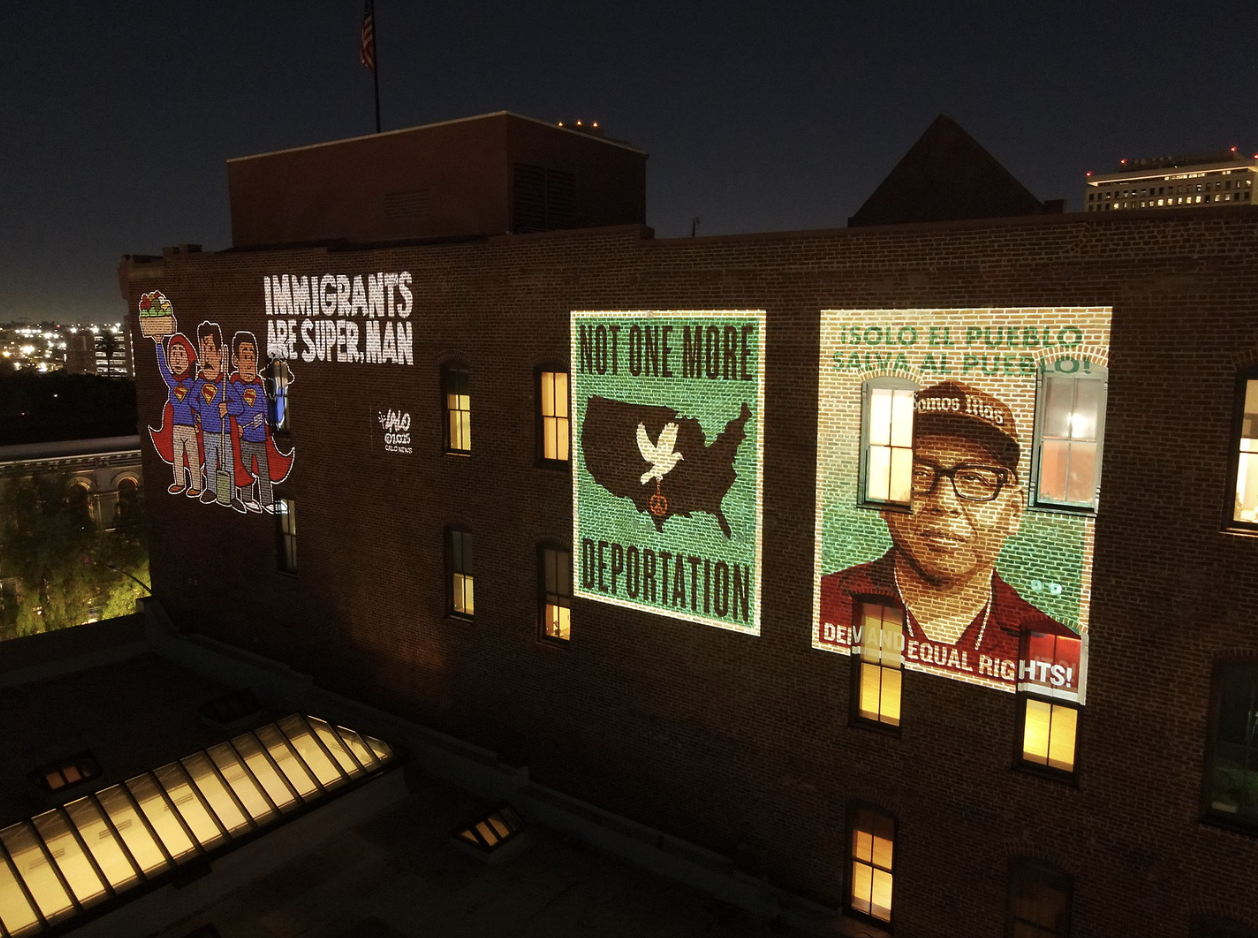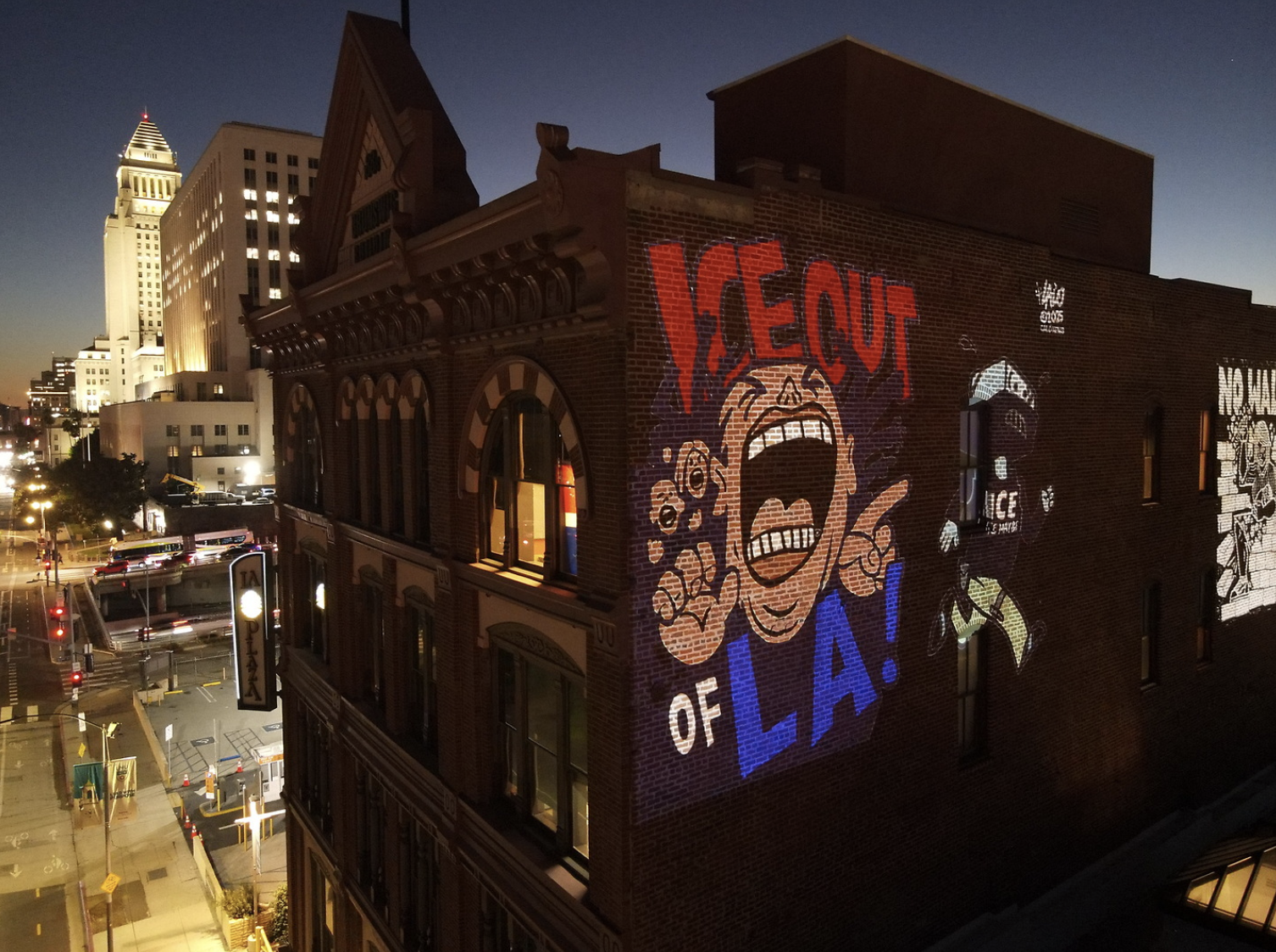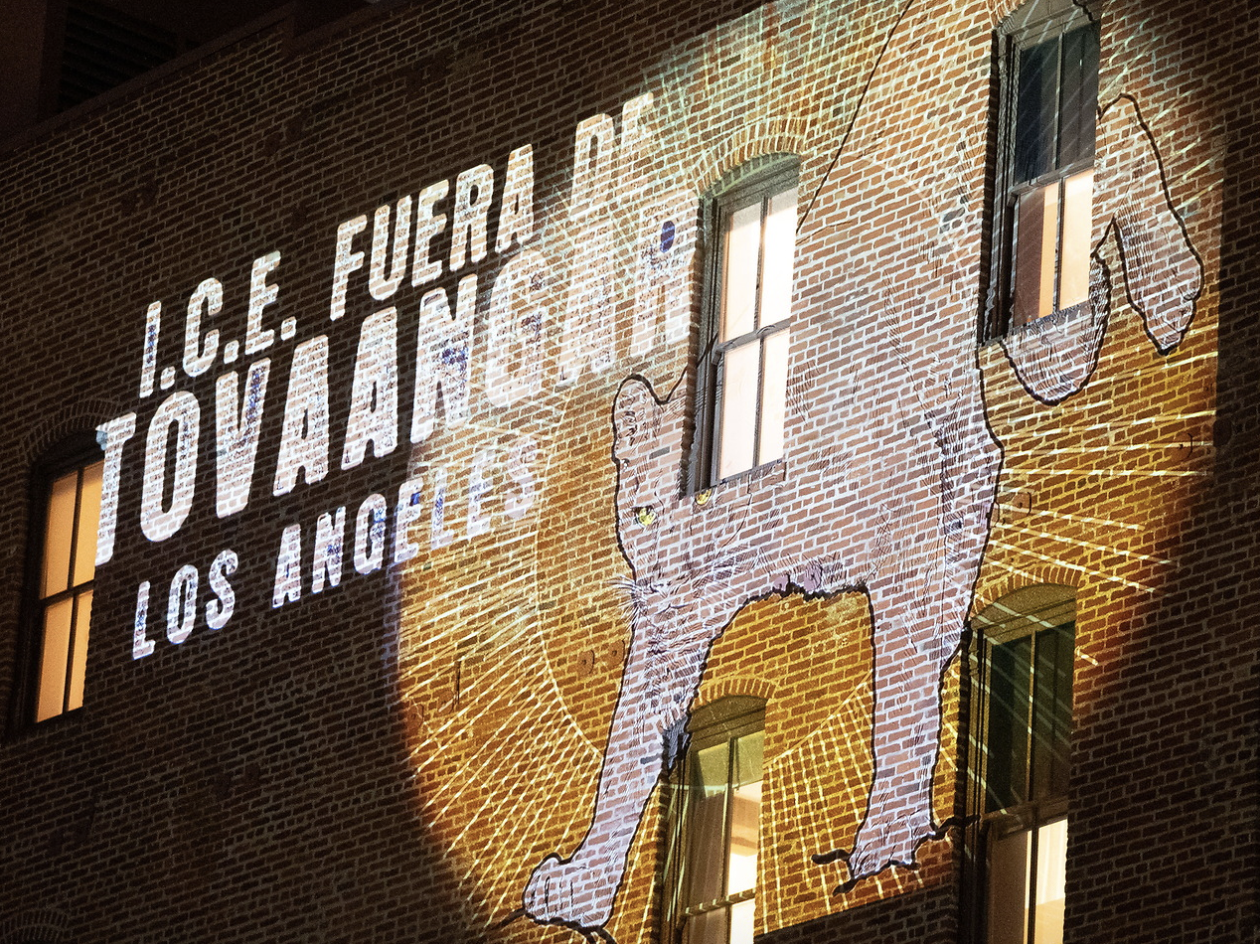In collaboration with four partner organizations, the project features large-scale projections exploring the ongoing realities faced by immigrant and undocumented communities in Los Angeles



LOS ANGELES (November 6, 2025) –– LA Plaza de Cultura y Artes, in partnership with four local institutions, unveils a region-wide public art installation project that transforms its exterior walls into a nightly canvas of resistance. Displayed nightly from sunset to dawn, these works explore realities faced by immigrant and undocumented communities in Los Angeles as well as themes of resilience and community resistance.
Participating organizations include LA Plaza de Cultura y Artes, the California Community Foundation (CCF), the Japanese American National Museum (JANM), the Social and Public Art Resource Center (SPARC), and the Museum of Latin American Art (MOLAA). Each site presents a distinct selection of images reflecting its own artistic and cultural perspective.
At LA Plaza de Cultura y Artes, the installation project—titled We Belong Here and on view for an indefinite period—features over 30 large-scale images created by nine Los Angeles–based artists: Brandy González, Ernesto Yerena Montejano, Joel García, John Fleissner, Lalo Alcaráz, Las Chicas Peligrosas, Lilia Ramírez “Liliflor,” Man One, and Mario Hernández. These striking artworks use bold graphic design and visual storytelling—through digital images and works in various mediums including posters and acrylic on canvas—to reflect the immigrant experience and call for justice and equity.
The project at LA Plaza also features a display of 13 neon artworks by Los Angeles–based artist Patrick Martinez, installed on the museum’s façade windows. The pieces illuminate powerful messages such as “THEN THEY CAME FOR ME,” “I DON’T SEE ANY AMERICAN DREAM, I SEE AN AMERICAN NIGHTMARE,” “TONGVA LAND,” “AMERICA IS FOR DREAMERS,” “INVEST IN THE OPPRESSED,” and “IT IS THE WEAK WHO ARE CRUEL.”
“At a time when diversity is under attack, our mission has never been more urgent,” says Leticia Rhi Buckley, CEO of LA Plaza de Cultura y Artes. “We remain steadfast in amplifying the voices and lived experiences of the Latino community, using our space as both a testament to our heritage and a sanctuary for belonging, and we remain responsive to what is happening in Los Angeles.”
The projection’s location at LA Plaza, just across from Olvera Street, serves as a poignant reminder of a dark chapter in US history. In February 1931, federal agents carried out a midday raid on this very street, detaining 400 people. This raid was among many that led to the deportation of approximately 400,000 people from California and more than a million across the United States—tearing families apart and disrupting countless lives during the Unconstitutional Deportations.
CCF and JANM feature photographs of everyday Angelenos under the tagline Am I Next? JANM’s installation also incorporates images from the Japanese American experience.
Projections at SPARC include portraits on shoebox ofrendas of disappeared undocumented community members that were contributed through an open call and workshops hosted by SPARC, including many of its staff muralists. The projections and shoebox ofrendas are also a part of SPARC’s Día de los Muertos exhibition Desaparecidos on view now at the Durón Gallery in Venice.
The projected images across all five institutions serve as a collective reminder of the injustices embedded in federal immigration policies. This partnership project honors the resilience, contributions, and voices of immigrant and undocumented communities, and affirm that silence is not an option.
###
Image 1 (left): Lalo Alcaraz, 2025, Immigrants Are Super, Man, Digital Image Projection, Artwork courtesy of Lalo Alcaraz ©Lalo Alcaraz
Image 1 (center): Ernesto Yerena Montejano, 2021, Not One More Deportation, Digital Image Projection, Artwork courtesy of Ernesto Yerena Montejano ©Ernesto Yerena Montejano
Image 1 (right): Ernesto Yerena Montejano, 2025, ¡Solo El Pueblo Salva al Pueblo! Demand Equal Rights! Digital Image Projection, Artwork courtesy of Ernesto Yerena Montejano ©Ernesto Yerena Montejano
Image 2: Lalo Alcaraz, 2025, ICE Out of LA, Digital Image Projection, Artwork courtesy of Lalo Alcaraz ©Lalo Alcaraz
Image 3: Joel Garcia, 2025, I.C.E. Fuera de Tovaangar, Digital Image Projection, Artwork courtesy of Joel García ©Joel García
***
Brandy Gonzalez
I am honored to participate in LA Plaza de Cultura y Artes’ We Belong Here, which boldly amplifies the voices and resilience of our communities. My selected works, Separation and Revolt Rebel, confront the realities of immigrant struggle while affirming the unbreakable spirit of resistance and solidarity.
Separation reflects the violence of family division at the border, a wound symbolized by the torn paper cutting through a mother’s wrist, with crosses marking lives lost in the journey. Revolt Rebel channels collective strength, a raised fist rising against a backdrop of calavera-flower wallpaper, a reminder that beauty and defiance often coexist.
As a San Antonio artist born and raised, I come from a place where the minority is the majority, and our cultural ties are our strength. I see this same spirit in Los Angeles, where our roots and struggles are deeply connected. To have these images projected on a massive scale is to transform grief into power, silence into visibility, and art into solidarity.
The most potent weapon in the hands of the oppressor is the minds of the oppressed. Through public art, we reclaim space, affirm dignity, and declare: ¡Viva la Raza!
Ernesto Yerena Montejano
I am honored to be a part of this visual resistance project, We Belong Here. One way we can show our disapproval of the fascist oppression that is happening to our communities at the hands of ICE and the Trump administration is to display political art in public spaces. I hope these images help people empower themselves. I also hope that these images help garner further support for the most vulnerable people in our city, with love and solidarity for our communities.
Joel García
For me, it is important that an Indigenous perspective on immigration is included, especially highlighting the Indigenous history of this area, specifically the Tongva and Tataviam presence before and after this place called Los Angeles. Additionally, it is important to shift focus away from solely the human experience regarding how harmful immigration policies are to the environment. Inhumane policies also harm other lifeforms and ecosystems.
John Fleissner
I’m proud my work can be utilized to serve in social movements for justice. The relief print has a long tradition being used to fight injustice, from German Expressionist woodcuts against war, to the relief prints of revolutionary Mexico building solidarity with workers and peasants. I hope to be a part of this continued tradition, where printmaking is used to communicate our values and ideals; bold and graphic.
I work as a teacher in a high school with students from all parts of the world. My fellow education workers and our students share common needs; to gain more of the good things in life, free from want and exploitation. We are stronger when we stick together in this pursuit, and that means defending one another. An injury to one is an injury to all. Art can be a powerful tool in our movement for a better world, to exemplify our aims, to rally others to our cause, and to give life and energy to the movement.
These two prints, No Pasaran and No Walls have been used as tools in the fight for immigrant rights. These posters have lived on picket signs at protests, pasted onto walls on the street, and lined the walls of classrooms. They’ve been carried at May First protests for immigrant rights and in marches on the Federal Detention Center in Downtown Los Angeles against the new wave of raids. With our collective action and solidarity, we can build a better world free from ICE terror.
Lalo Alcaraz
Los Angeles walls have always been canvases of protest and pride. My art belongs in that tradition - bold, loud, and unapologetically Chicano. This project isn’t about decoration. It’s about a declaration. By projecting our stories across the city, we make sure our resistance can’t be ignored. My goal is simple: to use art as both a weapon and a shield, to reflect the dignity of our communities, and to spark the imagination of what justice looks like. If one young person sees themselves ten stories tall, or one elder feels their struggle honored, then the art has done its job.
Las Chicas Peligrosas
In the current state of the world, where our immigrant community is under attack, it’s important to show the resistance and mobilization we have created to protect our neighbors. Projecting artwork in a highly visible space and at a large scale gives reassurance to our community members while letting them know we stand with them against the injustices they are facing. It shares the reality of what we are facing beyond the institutions’ walls and, most importantly, the need for people to take action and join a form of community defense.
Lilia Flores “Liliflor”
I am participating in LA Plaza de Cultura y Artes’ We Belong Here because I believe in the power of art as resistance, memory, and community healing. As an artist, my work is rooted in telling the stories of everyday people—our labor, our struggles, and our resilience. This project creates space to honor those voices and stand in solidarity with undocumented friends, neighbors, and families who continue to face unjust targeting and erasure.
To me, art is not passive decoration—it is a living testament. By transforming public space into a collective canvas, I hope to uplift the dignity, contributions, and survival of our communities in Los Angeles. My participation is an act of both remembrance and defiance: to affirm that our stories will not be silenced, and to imagine futures built on justice, belonging, and care.
“Man One” (Alejandro Poli Jr.)
Graffiti tagging of buildings is one of the most universal forms of political protest. By “tagging” the buildings with art projections, my art is literally amplified onto any surface at a scale unachievable in one night with a simple spray can. Using my art to protest the current situation we are facing as Latinos and immigrants in this country is the least I could do for my L.A. community.
Mario A. Hernandez
As an immigrant from Mexico who grew up in East Los Angeles, I have witnessed firsthand the resilience, challenges, and vibrant cultural traditions that define the Latino community. We are a people shaped by hard work, humility, and strong family values, qualities that continue to inspire my creative journey.
My artwork is deeply rooted in the richness of our heritage. It often blends traditional Mexican motifs and symbols with elements of the American experience, creating a visual narrative that reflects both my personal story and the collective story of our community. Through my work, I aim to celebrate our culture while also shedding light on the struggles we face, challenges like systemic inequality, cultural erasure, and economic injustice.
Over the years, I have come to understand the power of art as a form of activism. It is a tool for resistance, healing, and connection. Art gives us a voice when words fail and allows us to reclaim space in places where our stories have been ignored or silenced. Through my murals and public art pieces, I strive to spark dialogue, promote cultural pride, and share messages of hope, unity, and resilience.
Being invited to participate in this public art project is a profound honor. It represents an opportunity not only to share my own vision but also to contribute to a larger collective effort, one that uses the universal language of art to speak across borders, languages, and lived experiences. I am grateful to be part of something that amplifies the voices of our community and brings our stories to the forefront.
